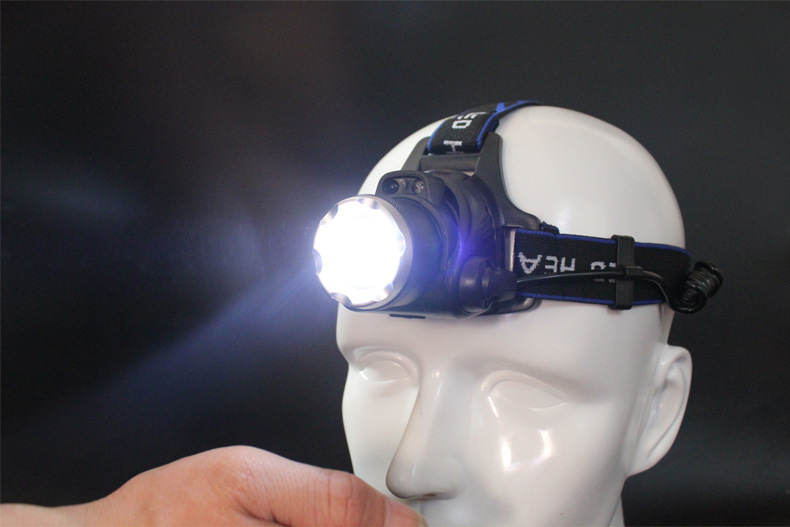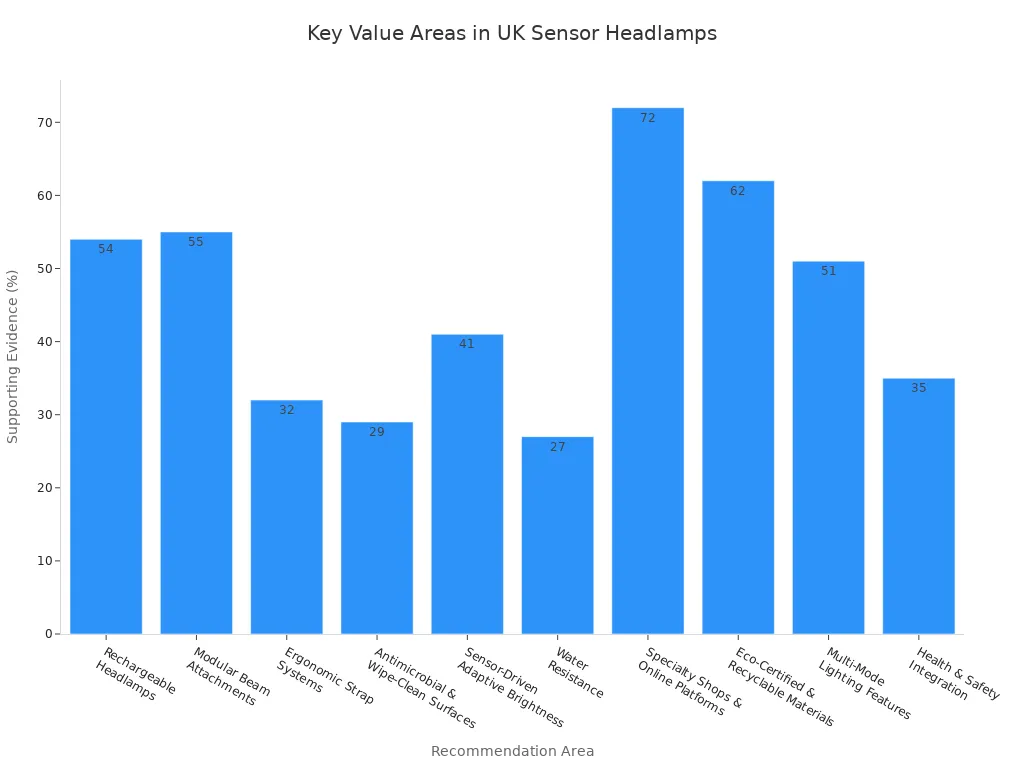
Retailers in the UK have seen impressive profits from high-margin sensor headlamps. Argos and Halfords stand out as leaders in this segment, consistently outperforming competitors in both revenue and margin. Data shows that high-margin sensor headlamps provide a significant boost to overall retailer profitability. These products offer advanced features, such as motion and proximity sensors, which attract consumers seeking convenience and efficiency. Retailers who prioritize this category often report stronger financial results and increased customer loyalty.
Key Takeaways
- High-margin sensor headlamps with advanced features like motion sensors boost UK retailers’ profits and attract loyal customers.
- Argos and Halfords lead the market by offering exclusive models, strong supplier partnerships, and excellent customer service.
- Retailers succeed by using smart pricing, combining online and in-store sales, and focusing on innovation and supply chain efficiency.
- Consumers prefer headlamps with hands-free operation, multi-mode brightness, and eco-friendly materials, shaping market demand.
- Retailers who invest in staff training, exclusive products, and sustainable options can increase profits and stand out in the market.
High-Margin Sensor Headlamps Market Overview

Market Size and Growth Trends
The UK market for sensor headlamps has experienced robust growth over the past five years. Retail analysts estimate that the market value surpassed £120 million in 2023, with a compound annual growth rate (CAGR) of 8%. This expansion reflects rising consumer demand for advanced lighting solutions in both outdoor and professional settings. Retailers have responded by increasing their product offerings and investing in marketing campaigns that highlight the benefits of sensor technology.
Several factors drive this growth. Outdoor enthusiasts, such as hikers and runners, seek reliable hands-free lighting. Professionals in construction and repair industries also require efficient illumination for precision tasks. The adoption of sensor headlamps in emergency kits and home use has further expanded the customer base. Retailers report that high-margin sensor headlamps now account for a significant share of total headlamp sales, contributing to higher overall profitability.
Note: Market research indicates that online sales channels have accelerated growth, especially as consumers seek convenience and access to a wider range of models.
Defining High-Margin Sensor Headlamps
High-margin sensor headlamps represent a premium segment within the broader headlamp market. These products feature advanced motion and proximity sensors that automatically adjust light output based on user movement and surrounding conditions. This technology allows users to focus on their activities without manual adjustments, enhancing both safety and efficiency.
Manufacturers often use high-quality materials and incorporate long-lasting batteries to support these features. Retailers classify a headlamp as “high-margin” when it delivers a profit margin significantly above the category average, often due to exclusive features, brand reputation, or private label offerings. The combination of innovative technology and strong consumer demand positions high-margin sensor headlamps as a key driver of profitability for leading UK retailers.
UK Retailer Profitability Rankings for High-Margin Sensor Headlamps
Top UK Retailers by Profit
Argos and Halfords lead the UK market in profits from high-margin sensor headlamps. These retailers have built strong reputations for offering advanced lighting solutions. Their focus on innovation and customer experience has set them apart from competitors.
- Argos maintains a broad inventory and leverages its extensive distribution network. This approach ensures product availability both online and in stores.
- Halfords specializes in automotive and outdoor equipment. The company invests in staff training and product demonstrations, which drive higher conversion rates.
Other notable retailers include Go Outdoors and Screwfix. These companies have expanded their product lines to include premium sensor headlamps, but they have not matched the profit levels of Argos and Halfords.
Note: Retailers that prioritize exclusive models and private label offerings often achieve higher margins in this category.
Key Profit Drivers in High-Margin Sensor Headlamps
Pricing Strategies
Retailers in the UK use strategic pricing to maximize profits from high-margin sensor headlamps. They often position these products as premium solutions, reflecting their advanced features and superior performance. Many retailers adopt value-based pricing, which sets prices according to the perceived benefits for consumers. This approach allows them to capture higher margins, especially when customers seek hands-free lighting with motion and proximity sensors.
Dynamic pricing also plays a significant role. Retailers monitor competitor prices and adjust their own to remain competitive while protecting profitability. Promotions and bundled offers encourage customers to purchase sensor headlamps alongside related accessories. These tactics drive higher average transaction values.
Tip: Retailers who regularly review and update their pricing strategies often outperform those who rely on static pricing models.
Supplier Relationships
Strong supplier relationships contribute directly to retailer profitability in this segment. Leading retailers negotiate favorable terms with manufacturers, securing priority access to the latest sensor headlamp models. These partnerships often result in better wholesale pricing, exclusive product variants, and reliable inventory replenishment.
Retailers who maintain open communication with suppliers can respond quickly to shifts in consumer demand. They also benefit from joint marketing initiatives and early insights into upcoming product innovations. This collaboration helps retailers differentiate their offerings and maintain a steady supply of high-margin sensor headlamps.
- Retailers with long-term supplier agreements often receive:
- Early access to new technology
- Volume discounts
- Enhanced support for product launches
Exclusive and Private Label Models
Exclusive and private label models represent a major profit driver for UK retailers. By offering sensor headlamps that are unavailable from competitors, retailers create a unique value proposition. Private label products, developed in partnership with manufacturers, allow retailers to control design, features, and branding. This control leads to higher profit margins and increased customer loyalty.
Exclusive models often feature advanced sensor technology, extended battery life, and premium materials. Retailers promote these products through targeted marketing campaigns, both online and in-store. Customers seeking the latest innovations gravitate toward these exclusive options, boosting overall sales and profitability.
Note: Private label and exclusive models help retailers avoid direct price competition, further supporting strong margins in the high-margin sensor headlamps category.
In-Store vs. Online Sales Performance
Retailers in the UK have seen significant shifts in sales channels for high-margin sensor headlamps. Both in-store and online platforms contribute to overall profitability, but each channel offers unique advantages and challenges.
In-Store Sales Performance
Physical stores remain important for many UK retailers. Customers often prefer to see and test sensor headlamps before making a purchase. Staff demonstrations and hands-on displays help shoppers understand advanced features, such as motion and proximity sensors. Retailers like Halfords invest in employee training to ensure knowledgeable service. This approach increases customer confidence and drives higher conversion rates.
In-store promotions and bundled offers also encourage impulse purchases. Many consumers visit stores for immediate needs, such as last-minute camping trips or emergency repairs. Retailers benefit from cross-selling opportunities, pairing high-margin sensor headlamps with related accessories.
Online Sales Performance
Online sales have grown rapidly in recent years. Retailers like Argos and Screwfix leverage robust e-commerce platforms to reach a wider audience. Online channels provide detailed product information, customer reviews, and comparison tools. These features help buyers make informed decisions without visiting a physical location.
E-commerce platforms offer several advantages:
- 24/7 availability for shopping convenience
- Access to a broader range of models and exclusive online deals
- Fast shipping and easy returns
Retailers use targeted digital marketing to attract specific customer segments. Search engine optimization and social media campaigns highlight the benefits of high-margin sensor headlamps, driving traffic to online stores.
Note: Data from industry reports shows that online sales now account for over 40% of total sensor headlamp revenue in the UK. This trend continues to accelerate as consumers seek convenience and variety.
Comparative Analysis
Both channels play a vital role in retailer strategy. In-store sales excel at building customer trust and supporting premium pricing. Online sales drive volume and expand market reach. Leading retailers integrate both approaches, offering click-and-collect services and seamless returns to enhance the customer experience.
A balanced channel strategy allows retailers to maximize profits from high-margin sensor headlamps. They can adapt quickly to changing consumer preferences and market conditions.
Comparative Margin Analysis Across UK Retailers
Margin Differences Among Leading Retailers
Profit margins for sensor headlamps vary widely across the UK retail landscape. Retailers typically achieve higher margins than wholesalers, reflecting their ability to set premium prices and leverage brand reputation. The following table illustrates the general profit margin ranges observed in the market:
| Seller Type | Profit Margin Range |
|---|---|
| Wholesalers | 10% – 30% |
| Retailers | 20% – 50% |
Retailers such as Argos and Halfords often operate at the upper end of this range. Their focus on exclusive models, private label offerings, and advanced product features allows them to command higher prices. In contrast, wholesalers face tighter margins due to bulk sales and lower pricing flexibility. The margin gap highlights the importance of retail strategy and customer engagement in driving profitability.
Factors Influencing Margin Variations
Several factors contribute to margin differences among UK retailers. Operational costs and supply chain management play a significant role in shaping profitability. Key influences include:
- Rising operational costs, especially wage bills driven by increased National Insurance Contributions and the National Living Wage, are expected to increase wage expenses by £7 billion in 2025.
- Many retailers plan to raise prices, reduce staff hours, cut headcount, or invest in automation to protect margins.
- Supply chain inefficiencies, such as loss and theft of pallets and totes, cause significant financial losses. Addressing these issues through asset protection and logistics audits can save millions annually.
- Optimizing supply chains by reducing unnecessary vehicle journeys and adopting circular economy principles, like closed-loop pallet pooling, improves cost control and operational efficiency.
- Only a small percentage of businesses globally participate in circular economy models, presenting an opportunity for retailers to enhance supply chain resilience and margin stability.
- Proactive supply chain management helps retailers mitigate margin pressures, enabling better control over costs and improved responsiveness.
Retailers who invest in automation, logistics optimization, and innovative supply chain models often achieve more stable and higher profit margins. These strategies not only reduce costs but also support long-term competitiveness in the sensor headlamp market.
Case Studies: Argos and Halfords in High-Margin Sensor Headlamps
Argos: Strategy and Results
Argos has established itself as a leader in the sensor headlamp market by focusing on accessibility and product variety. The company maintains a broad inventory, offering both well-known brands and exclusive models. Argos uses its extensive online and physical store network to reach a wide customer base. The retailer invests in digital marketing campaigns that highlight the benefits of sensor technology, such as hands-free operation and adaptive lighting.
Argos leverages data analytics to monitor sales trends and adjust inventory quickly. The company often introduces limited-time promotions and bundled offers to increase average order value. Staff training ensures that in-store employees can demonstrate advanced features to customers. Argos also partners with manufacturers to secure early access to new models, which helps the retailer stay ahead of competitors.
Note: Argos reports strong growth in online sales, with over 50% of sensor headlamp purchases now occurring through its digital platform.
The results speak for themselves. Argos consistently ranks among the top UK retailers for profit and market share in this category. Customer feedback highlights satisfaction with product quality and convenience.
Halfords: Strategy and Results
Halfords approaches the sensor headlamp market with a focus on expertise and customer service. The retailer specializes in automotive and outdoor equipment, which aligns well with the needs of sensor headlamp buyers. Halfords invests in staff training programs, ensuring that employees can provide detailed product demonstrations and answer technical questions.
The company emphasizes exclusive and private label models, working closely with suppliers to develop products that meet specific customer requirements. Halfords uses in-store displays and interactive demos to engage shoppers. The retailer also integrates online and offline channels, offering click-and-collect services for added convenience.
Halfords tracks customer preferences and adjusts its product range accordingly. The company’s strategy results in high conversion rates and strong repeat business. Halfords has built a reputation for reliability and expertise, which drives customer loyalty and supports sustained profitability.
Implications for Retailers and Consumers in the High-Margin Sensor Headlamp Market
Lessons for Competing Retailers
Retailers entering or expanding in the sensor headlamp market must adapt to evolving consumer demands and market pressures. Success depends on several strategic actions:
- Prioritize Innovation: Retailers who offer products with advanced features, such as motion sensors and smartphone connectivity, attract a larger share of the market. Over 65% of consumers prioritize multi-mode brightness, while 75% show interest in smartphone integration.
- Balance Pricing and Value: Approximately 65% of buyers seek budget-friendly options. Retailers face challenges maintaining profit margins due to competitive pricing. They must find a balance between affordability and premium features.
- Embrace Sustainability: Nearly half of European consumers prefer sustainable headlamps. Retailers who stock eco-friendly models, such as those with solar-powered batteries, align with this growing demand.
- Strengthen Supplier Partnerships: Fluctuating raw material costs affect over 58% of manufacturers. Retailers benefit from strong supplier relationships, which help secure stable pricing and reliable inventory.
Tip: Retailers who invest in staff training and customer education can differentiate themselves and build loyalty.
The following table summarizes key consumer preferences and their impact on retailer profit margins:
| Consumer Preference / Market Factor | Statistic / Insight | Impact on Retailer Profit Margins / Market Dynamics |
|---|---|---|
| Price Sensitivity | ~65% prefer budget-friendly headlamps | Challenges in maintaining margins due to competitive pricing |
| Premium Feature Adoption | >70% of premium headlamps have motion sensor activation | Supports higher-value product demand and improved margins |
| Eco-friendly Focus | 68% of manufacturers focus on sustainable batteries | Growth opportunities through sustainability alignment |
| Consumer Feature Preferences | >65% want multi-mode brightness; 75% seek smartphone links | Drives demand for feature-rich products and potential margin gains |
Impact on Consumer Choices
Consumers now have more options and information than ever before. The market’s rapid growth, with a CAGR of 10.3%, reflects rising interest in advanced sensor features and sustainable solutions. Shoppers increasingly look for headlamps that offer hands-free operation, adaptive lighting, and long battery life. Many buyers also consider environmental impact, choosing products with eco-friendly materials and energy-efficient designs.
Retailers respond by expanding product ranges and highlighting innovative features. Consumers benefit from improved product quality, greater variety, and enhanced shopping experiences both online and in-store. As a result, buyers can select headlamps that best match their needs, whether for outdoor activities, professional use, or emergency preparedness.
Note: The shift toward sustainability and smart technology in headlamps empowers consumers to make choices that reflect both personal values and practical requirements.
Argos and Halfords lead the UK market for high-margin sensor headlamps, consistently achieving strong profits. Key profit drivers include advancements in intelligent lighting, adoption of adaptive technologies, and regulatory support. Retailers benefit from exclusive models and optimized supply chains. Consumers seeking value should consider features such as rechargeable batteries, modular beams, and ergonomic designs.
| Recommendation Area | Supporting Insights |
|---|---|
| Rechargeable Headlamps | 54% of campers prefer; USB charging extends trips by 42% |
| Modular Beam Attachments | 55% of new products offer modular platforms |
| Ergonomic Strap Systems | 32% of design budgets target ergonomic straps |
| Antimicrobial & Wipe-Clean Surfaces | 29% of prototypes feature antimicrobial housing |
| Sensor-Driven Adaptive Brightness | 41% of new models use sensor-based lumen adjustment |
| Water Resistance | 27% of R&D targets water resistance beyond IPX8 |
| Specialty Shops & Online Platforms | Specialty shops drive 15% of sales; online stores hold 72% revenue |
| Eco-Certified & Recyclable Materials | 62% of consumers prefer eco-certified; 49% seek recyclable materials |
| Multi-Mode Lighting Features | 51% require adjustable beams; 36% demand red-light modes |
| Health & Safety Integration | 35% of new products feature health-safety technologies |

Retailers who focus on innovation and supply chain efficiency can maximize margins. Consumers should prioritize adaptive features and sustainable materials when selecting high-margin sensor headlamps.
FAQ
What makes a sensor headlamp “high-margin”?
Retailers classify a sensor headlamp as “high-margin” when it delivers above-average profit. These models often feature advanced sensors, premium materials, and exclusive designs. Retailers can set higher prices due to strong demand and unique features.
Why do UK retailers focus on exclusive and private label sensor headlamps?
Exclusive and private label models allow retailers to control design, branding, and pricing. This strategy reduces direct competition and increases profit margins. Retailers also build customer loyalty by offering products unavailable elsewhere.
How do motion and proximity sensors benefit users?
Motion and proximity sensors enable hands-free operation. The headlamp automatically adjusts brightness or turns on and off based on movement. This feature improves convenience, saves battery life, and supports tasks that require precision.
Are online or in-store sales more profitable for sensor headlamps?
Both channels contribute to profits. In-store sales benefit from product demonstrations and immediate purchases. Online sales reach a wider audience and offer convenience. Leading retailers integrate both channels for maximum profitability.
Post time: Jul-18-2025
 fannie@nbtorch.com
fannie@nbtorch.com +0086-0574-28909873
+0086-0574-28909873





